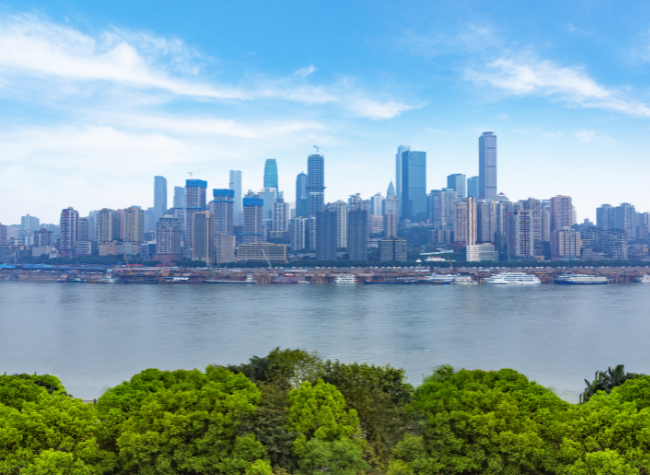 Bridging News
Bridging News
Nine Goals to Construct Beautiful Chongqing
Chongqing - On November 17th, Chongqing announced the phased goals for the iterative upgrade of water treatment, air purification, soil conservation, waste management, plastic reduction, mountain protection, riverbank governance, urban management, and rural development. By 2027, the sky will be bluer, the water will be clearer, and the air fresher.

The city view of Chongqing. (Photo/IChongqing)
According to data, as of the end of October, the water quality of the Yangtze River in the Chongqing section remains at Level II, with 100% of the 74 national control sections having excellent water quality. The air quality boasts 276 days of excellence, while soil, noise, and radiation environmental quality remain stable, with no significant or above sudden environmental incidents reported.
The construction of Beautiful Chongqing is a crucial goal in developing a modernized new Chongqing, representing the city's most recognizable and iconic "golden name card."
Yu Guodong, the director of the Chongqing Municipal Ecology and Environment Bureau, outlined the phased goals and measures for the construction of Beautiful Chongqing, emphasizing a determined effort to wage war on pollution control and ecological protection in the Yangtze River Economic Belt.
Water Treatment
Chongqing will implement projects such as high-quality sewage treatment, rectification of sewage outlets, restoration of aquatic ecosystems, and water environmental security projects.
It is expected that by 2027, the proportion of national assessment sections of surface water reaching or surpassing Level III will be no less than 98.6%, the water quality of urban assessment sections will meet the standard of 100%, and the elimination rate of black and odorous water bodies in cities will be 100%.
Air Purification
Initiatives include eliminating heavy pollution days, preventing and controlling ozone pollution, managing diesel truck pollution, and others.
By 2027, the overall air quality in the city will continue to improve, heavy pollution days will be eliminated, and the proportion of excellent air quality days will stabilize at 92.6% or above. The annual average concentration of PM2.5 will be controlled within 31 micrograms per cubic meter.
Soil Conservation
Projects will focus on preventing and controlling soil pollution in agricultural land, ensuring safe utilization of construction land, and managing risks to groundwater environments.
By 2027, it is projected that the safe utilization rate of contaminated cultivated land will stabilize at 93% or above.
Waste Management
Initiatives will include urban garbage classification management, comprehensive utilization of industrial solid waste, safe disposal of hazardous waste (medical waste), treatment of new pollutants, and the construction of "zero-waste city cells."
By 2027, the harmless disposal rate of urban sludge will reach nearly 100%, and the harmless treatment rate of urban household garbage will also achieve 100%. Over 5000 "zero-waste city cells" will be established, and the city's hazardous waste utilization and disposal capacity will meet actual demands.
Plastic Reduction
Efforts will involve reducing and substituting plastic at the source, recycling and disposing of plastic waste, and addressing plastic waste in key areas.
By 2027, the city's recycled plastic utilization will exceed 750,000 tons, the recycling rate of agricultural film will increase to 95%, and the proportion of household waste incineration will reach over 80%.
Mountain Conservation
Projects will focus on ecological space control, protection and enhancement of the "Four Mountains" in the central urban area, protection of important ecosystems, and restoration of ecologically degraded areas.
By 2027, the city's forest coverage rate will stabilize at 55% or above. The area of soil erosion control will increase by more than 4,000 square kilometers, and the national plan for desertification control will be fully implemented, with a soil conservation rate of 73%.
Riverbank Protection
Initiatives will include the protection and restoration of river and lake shorelines, improvement of the core areas and waterfront areas of the "Two Rivers and Four Banks," control of chemical industry pollution along the river, and comprehensive treatment of tailings dam pollution.
By 2027, environmental management will cover 100 kilometers in the subsidence area of the Three Gorges Reservoir, and the core areas and waterfront areas of the "Two Rivers and Four Banks" will significantly improve. Pollution sources from chemical industries along the river will be comprehensively addressed, and the environmental and safety risks of tailings dams will be under control.
Urban Governance
Projects will address comprehensive control of cooking fumes and odors, noise environmental impact management, improvement of urban green space quality, and ecological protection of central city islands.
By 2027, 750 "quiet communities" will be created, and the nighttime compliance rate of functional areas will reach 85% or more. The green space ratio in the urban built-up area will strive to get 40% or more.
Rural Development
Initiatives will include rural toilet renovations, household garbage classification and management, and strengthening rural sewage's basic and efficient treatment.
By 2027, the level of agricultural and rural pollution control will significantly improve, the living environment in rural areas will continue to improve, and the city will strive to build 320 ecological civilization construction demonstration towns (streets) and 1000 uniquely livable and business-friendly, beautiful rural villages.
 Related Stories
Related Stories